 |
The Saint of the Day
St. Henry II, Emperor - July 15
Prof. Plinio Correa de Oliveira
Biographical selection:
St. Henry II (972-1024), Duke of Bavaria, became Emperor of the Holy Roman German Empire. He placed his army under the blessing of God and used to invoke the patron saints of his people, especially St. Adrian, a military martyr, whose sword was carefully conserved as a relic for a long time in Walbach.
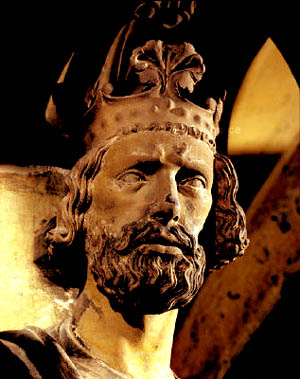
St. Henry II, Holy Roman German Emperor
|
With this protection he organized an army and defeated the barbarians from the East who were invading Western Europe. Before facing the pagan Slavs, who were much superior in strength, he called on his army to pray and receive Communion. When the troops entered combat, an unexpected panic took hold of the enemy soldiers, who broke ranks and fled en masse. An Angel and three martyrs led his troops, causing the enemy to take flight in despair. The Slavs submitted to his rule, and Bohemia, Moravia, and Poland were in turn annexed to the Holy Empire.
In 1006, he called a meeting of the Bishops in Frankfurt with the objective of regulating many points of discipline and enforcing a stricter observance of the ecclesiastical canons. Later, he would support the reform movement of Cluny.
Twice he defeated the Lombards, who resisted the consolidation of the Empire and threatened the Pontifical States. After his first victory in 1004, he was crowned King of Lombardy in Pavia with the famous Iron Crown of that Kingdom. The second time, he had to do more than pacify the Lombards, since grave problems were afflicting the Church. Henry drove out an antipope, and brought the legitimate Pope Benedict VIII back to Rome.
When he and Empress Cunigunde went to Rome to visit the Pope, they were crowned Emperor and Empress of the Romans. The Sovereign Pontiff gave St. Henry a golden orb, a symbol of the imperial dignity, inlaid with pearls and topped by a cross. St. Henry, dignified by the many honors, gave the orb to St. Odilon, Abbot of Cluny, who was present at the ceremony so that those symbols would be conserved at the Monastery of Cluny.
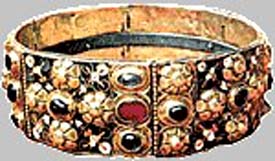
Henry II was crowned with the Iron Crown of Lombardy. Embedded in it is one of the iron nails that crucified Our Lord
|
St. Henry approached Stephen, King of Hungary, who was still a pagan and had not been received into the bosom of the Church. St. Henry II made an alliance with him, offering him the hand of his sister, Gisele, as his wife. Soon afterward King Stephen was baptized and the whole nation was brought to the faith of Christ. With the marvelous conversion of Stephen, Henry won a great King for the Church and a Saint for Heaven.
After other military expeditions in Italy that resulted in the re-establishment of peace in the peninsula, he returned to Germany. On his way back, when he reached Luxembourg, he had a famous meeting with Robert, King of France, to resolve various political problems of Europe. The meeting was scheduled to take place on the banks of the Meuse River, which occasioned a problem of protocol. If one Sovereign crossed the river to enter the other’s domain, the former would be subject to the laws of the latter. To resolve the delicate situation, it was planned for the Sovereigns to meet in boats in the middle of the river – a neutral area. But St. Henry disregarded the protocol and crossed to the French side in consideration for the virtues of the French King.
Comments of Prof. Plinio:
This selection is somewhat wide-ranging because the life of St. Henry is full of memorable acts that should be reported. For us to have a good understanding of the ensemble of these facts, it is necessary to place them in their historical context.
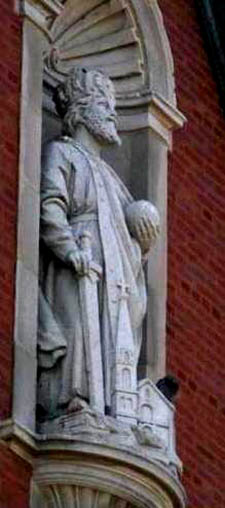
St. Henry II at St. Stephen's Church, Chicago
|
We are in the Middle Age, in the early 1000s. As you know, the Middle Age began with the fall of the Roman Empire in the West. It was invaded by incalculable hordes of barbarians. Those barbarians established themselves inside the imperial territory and ended by subjecting the Romans to their control.
Gradually the Roman population also fell into barbarianism. The roads were abandoned with no one to care for them; the aqueducts that supplied the cities with water broke and no one repaired them; the palaces occupied by barbarians became dirty and disorganized; works of art in public places were ruined, and the cities fell into chaos. Everything that represented culture and civilization was miserably destroyed. In this situation Europe became illiterate and its level of customs sunk to unimaginably low levels. It took centuries to bring Europe to a state of civilization again.
While everything was being crushed, the Catholic Church remained as the one existing institution. Those barbarians began to convert under her influence. The work the Church did with the European peoples was not so different from the work she later undertook to convert and civilize the Indians in the New World. The missionaries arrived, preached the catechism, and through successive generations the Indians became civilized and acquired a certain culture. The same took place with those European tribes.
In the year 1000, civilization had already achieved much in relation to the original barbarian way of living, but Catholic Civilization was still far below the standards it would reach 200 or 300 years later. That is to say, at the time of St. Henry II, we are in a semi-barbarian situation.
Some peoples were more civilized than others. In Europe there were islands of an incipient Catholic civilization amid a sea of barbarian peoples who continued to go and come at will and attack the established kingdoms. Catholic life was very difficult with adversaries coming from all directions.
One of the earliest conversions took place with the Germanic peoples who occupied the territory of present-day Germany, Austria, Slovakia, the Czech Republic and Switzerland. Those peoples became civilized and constituted a political entity called the Holy Roman German Empire. It was called Empire because it encompassed different peoples as a federation. Those free peoples agreed to be led – not governed – by a single political chief, elected by the various heads of State. So, as a league including a large territory and different peoples, it was called an Empire. It was called Roman because its model was the old Roman Empire; it was called German because it had been founded by German peoples; and it was called Holy because its principal finality was to defend the Catholic Church against the aggression of the pagans.
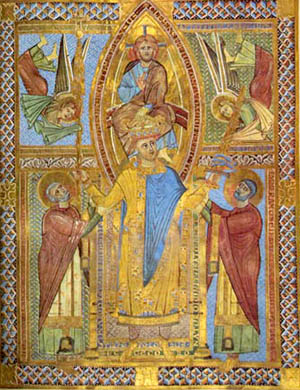
Christ crowns Henry II Emperor, showing that all power derives directly from Him. At right St. Udalrich holds his sword; at left, St. Emmeran holds his lance
|
In the person of St. Henry II, we see an Emperor who was also a Saint. That a great political leader and head of an army was a saint does not fit very well with the lives of the saints taught by a certain sentimental piety. Indeed, he held the highest office in the most important political organization of his time and was, therefore, the most powerful man in Europe. Simultaneously he was the greatest warrior of Europe and the first son of the Church. He was par excellence the son of the Church. He was the one who always protected the Church against the attacks of her enemies.
He also had to face the peoples of the East who continuously attacked the Empire. So he gathered together a large army and counter-attacked those barbarians. He waged many wars and acted as a Catholic hero who had the spirit of Faith, relying more on supernatural help than on his natural forces. He asked God for the might to win his battles. To show St. Henry how his prayers were pleasing to Him, God gave him a miraculous victory on one occasion. As the two armies came face to face, the enemy troops fled the battlefield in panic for apparently no reason. In fact, to terrify his enemies, God had sent an Angel and the holy martyrs to whom Henry II had prayed. God was so pleased with the prayers of the warriors that he gave them the victory even without the combat.
With this victory, the pagan forces from the East were broken and the claws of Paganism lost their strength.
But a danger still threatened Christendom: the presence of the Lombards in North Italy. Lombardy was not a land of pagans, but heretics who were enemies of the Catholic Faith. They used to attack the Pope and the Papal territories and opposed the Catholic Empire. So St. Henry, with the support of the Italian Bishops, entered Lombardy, defeated its army, and then went on to Rome to visit and pay homage to Pope Benedict VIII.
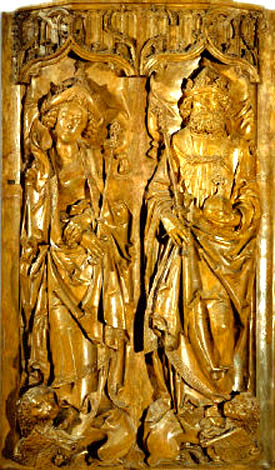
The tomb cover of St. Henry II
and his wife St. Cunigunde
|
It was on this occasion that the Pope crowned him Emperor of the Holy Roman German Empire. In a ceremony realized with great splendor, he gave St. Henry a golden orb inlaid with pearls representing the power of the Emperor over the world. But St. Henry did not keep that treasure. To prove his love for the Church, he offered the precious gift to the Holy Abbot Odilon, the head of the largest religious order of Europe at that time.
After inflicting new defeats on the revolted Lombards, he returned to Germany. There he assisted the Bishops to exert their role of maintaining discipline in the Church. He also was instrumental in the conversion of a pagan King. He offered an alliance with Stephen, King of Hungary, together with the hand of his sister Gisela. She married Stephen and converted him. She did so good a job that he became a saint, St. Stephen, who afterward converted all of Hungary to the Catholic Faith.
Behind this conversion was the intelligent diplomatic maneuver of St. Henry. With this he won a precious ally close to those Slavic enemy peoples who had just been pacified. His diplomatic sense was also demonstrated in the episode at the Meuse River, in which he gave up his privileges in order to please the French King. Crossing over to the French banks, St. Henry was implicitly paying homage to the King. That is, he who was more – an Emperor – paid homage to the one who was less in order to maintain cordial relations and to resolve the complicated problems of Europe.
After all these services to the Church and Christendom, St. Henry died in 1024 in the peace of God as a great saint, warrior, diplomat and politician. This is the glorious story of St. Henry II, Emperor.
Let us pray to him to help us establish the foundation of a new Christendom that will be the Reign of Mary.


  | | Prof. Plinio Corrêa de Oliveira | |
The Saint of the Day features highlights from the lives of saints based on comments made by the late Prof. Plinio Corrêa de Oliveira. Following the example of St. John Bosco who used to make similar talks for the boys of his College, each evening it was Prof. Plinio’s custom to make a short commentary on the lives of the next day’s saint in a meeting for youth in order to encourage them in the practice of virtue and love for the Catholic Church. TIA thought that its readers could profit from these valuable commentaries.
The texts of both the biographical data and the comments come from personal notes taken by Atila S. Guimarães from 1964 to 1995. Given the fact that the source is a personal notebook, it is possible that at times the biographic notes transcribed here will not rigorously follow the original text read by Prof. Plinio. The commentaries have also been adapted and translated for TIA’s site.
|
Saint of the Day | Home | Books | CDs | Search | Contact Us | Donate

© 2002- Tradition in Action, Inc. All Rights Reserved
|
 |

|